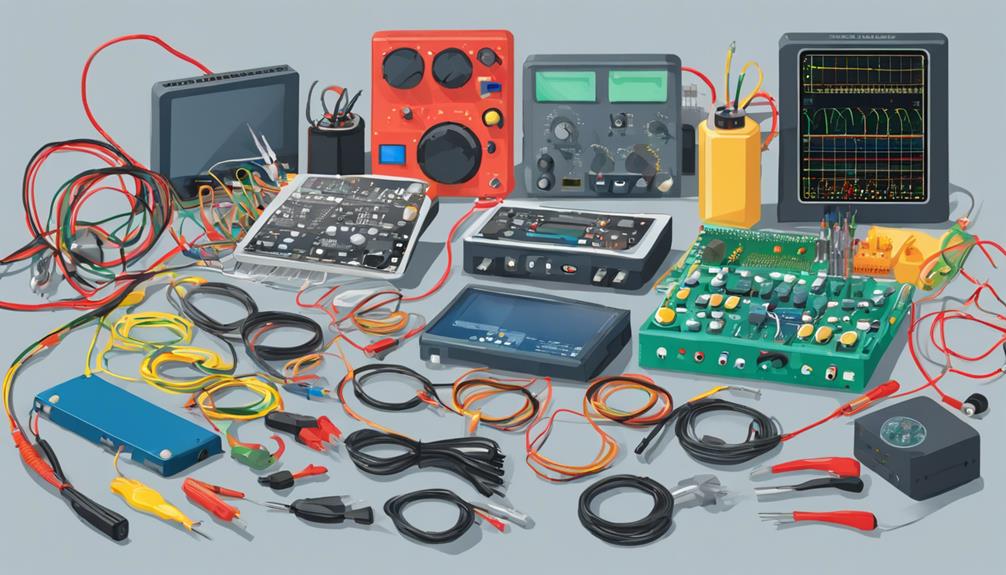Automated testing solutions are essential for streamlining production in electronics manufacturing, greatly reducing testing time and expenses while increasing test coverage and product quality. By leveraging automated testing tools, manufacturers can expedite their production cycles, guarantee quality assurance, and mitigate human error. With the ability to execute thousands of test cases efficiently, these solutions identify defects early in development, allowing for swift issue resolution. By integrating automated testing into their production processes, manufacturers can optimize their testing procedures, reduce resources, and stay ahead of competition. Discover how automated testing solutions can further transform your production landscape.
Key Takeaways
- Automated testing solutions reduce testing time by up to 80%, accelerating production cycles and time-to-market for software applications.
- Efficient electronic component testing detects defects swiftly, minimizing downtime and ensuring high-quality products.
- Automated testing optimizes resources, redirecting them towards strategic endeavors and saving up to 50% of testing expenses.
- Rapid test iterations ensure quality assurance, mitigating human error and enhancing overall software quality.
- Implementing automated testing solutions enables thorough testing of complex systems, improving product reliability and performance.
Understanding Automated PCB Testing
In the field of electronics manufacturing, automated printed circuit board (PCB) testing has emerged as an essential step in guaranteeing the reliability and functionality of electronic devices. This rigorous process involves utilizing software tools to detect faults in PCBs, thereby ensuring the quality and performance of the final product.
Automated testing enables the detection of defects such as short circuits, open circuits, and component failures, which are vital to identify to prevent product malfunction. In the electronics manufacturing process, PCB testing is essential to maintain quality standards, as even minor defects can compromise the overall performance of the device.
Benefits of Automated Testing Tools

The implementation of automated testing tools yields numerous benefits, including a faster time to market, reduced test cycle, and increased test coverage.
By leveraging these tools, organizations can expedite the testing process, thereby accelerating the release of software applications.
This, in turn, enables companies to stay ahead of the competition and capitalize on emerging market opportunities.
Faster Time to Market
By harnessing the power of automated testing tools, organizations can greatly accelerate their software development lifecycle, bridging the gap between development and deployment. This accelerated pace is largely attributed to the significant reduction in testing time, with automated testing tools capable of reducing testing time by up to 80% compared to manual testing methods.
Some key benefits of automated testing tools that contribute to a faster time to market include:
- Reduced testing time: Automated testing tools reduce testing time, allowing for quicker deployment of software products.
- Faster detection of defects: Automated testing tools help detect defects early in the development cycle, enabling quicker bug fixes and smoother releases.
- Improved testing efficiency: Automated testing increases testing efficiency by up to 50% while maintaining high levels of accuracy.
- Shorter project timelines: Implementing automated testing solutions can lead to a 20-30% reduction in overall project timelines, resulting in a faster time to market.
Reduced Test Cycle
Additionally, automated testing tools greatly reduce test cycle times, freeing up teams to focus on higher-value tasks and improving overall productivity and software quality.
By leveraging automation tools, test cycles can be reduced by up to 90%, accelerating product releases and enabling teams to respond quickly to changing market demands. This significant reduction in test cycle times is achieved by automating repetitive tasks, minimizing manual errors, and ensuring consistent results.
Continuous testing is also made possible, allowing for the quick identification of issues as they arise and facilitating faster feedback and bug resolution.
Furthermore, automation tools streamline the testing process, reducing the likelihood of errors and delays. As a result, teams can redirect their attention to more critical tasks, improving overall productivity and software quality.
Increased Test Coverage
Sophisticated automated testing tools greatly expand test coverage, enabling organizations to thoroughly evaluate their software applications across diverse platforms, browsers, and devices. This extensive coverage guarantees that software applications are reliable and of high quality.
Here are some key benefits of automated testing tools in increasing test coverage:
- Extensive coverage: Automated testing tools can execute a large number of test cases in a fraction of the time it would take manually, ensuring thorough test coverage.
- Detailed reporting: Tools like Selenium, TestComplete, and Tricentis Tosca offer detailed reporting and analysis capabilities, enhancing the visibility of test coverage.
- Early defect detection: With automation, businesses can detect defects early, reducing the likelihood of downstream problems and ensuring the reliability of their software applications.
- Simulation of user interactions: Automated testing tools simulate user interactions and behaviors, allowing for thorough test coverage that may not be feasible with manual testing methods.
Top Automated Testing Solutions

In the field of software testing, a range of top-tier automated testing solutions have emerged as industry leaders, each offering unique strengths and capabilities. These solutions have revolutionized automated software testing, enabling organizations to streamline their testing processes and improve test coverage.
One such solution is Selenium, an open-source tool that guarantees compatibility across browsers and platforms, backed by a vast community of supporters.
Another notable solution is Appium, which supports multiple programming languages and platforms, ensuring iOS and Android cross-platform compatibility.
TestComplete provides a visual test recorder for easier test creation, supporting desktop, web, and mobile applications.
Tricentis Tosca uses a model-based approach for test generation and maintenance, integrating with different testing tools and frameworks.
Additionally, Allure TestOps offers a cloud-based platform supporting multiple testing frameworks and providing detailed reporting and analytics.
These top automated testing solutions empower organizations to optimize their testing processes, reduce test data complexity, and accelerate automation testing. By leveraging these solutions, organizations can greatly enhance their testing capabilities and achieve improved test coverage.
How Automated Testing Works

By leveraging software tools to mimic human tester behaviors, automated testing enables organizations to streamline their testing processes and accelerate test execution. This approach eliminates the need for manual testing, which can be time-consuming and prone to errors. With automation, software tools execute pre-scripted tests swiftly and accurately, saving time and resources.
Here are the key aspects of how automated testing works:
- Automation: Software tools mimic human tester behaviors, such as mouse clicks and data inputs, to simulate real-world scenarios.
- Embedding: Automated testing integrates with development processes to embed quality from the start.
- Tools: Specialized software tools are used to execute tests, compare results, and generate detailed reports.
- Validation: Automated testing involves running pre-scripted tests to validate expected outcomes, identify inconsistencies, and facilitate quick issue resolution.
Optimizing Testing With Automation

As automation transforms the testing landscape, optimizing testing processes with automation becomes essential for maximizing efficiency and minimizing costs.
By leveraging automated testing, companies can reduce testing expenses by up to 50% compared to manual testing. This significant cost reduction is made possible by automation tools like TestComplete, which offers a visual test recorder for easier test creation and parallel testing capabilities for faster results.
Tricentis Tosca, on the other hand, uses a model-based approach for test generation and maintenance, integrating with various testing tools to guarantee thorough testing.
To guarantee high software quality standards, Softweb Solutions specializes in implementing tailored test automation frameworks. These frameworks enable companies to streamline their testing processes, reducing the time and resources required for testing.
Streamlining PCB Production Processes

Implementing automated testing solutions in PCB production processes can greatly boost efficiency, reduce defects, and enhance overall product reliability. By integrating automated testing tools, manufacturers can streamline their production processes, resulting in significant cost savings and improved productivity.
Here are four key benefits of automated testing in PCB production:
- Improved Efficiency: Automated testing solutions can speed up the production of PCBs by reducing the time spent on testing and inspection.
- Enhanced Quality Assurance: Automated testing can reduce human error in PCB assembly, ensuring higher quality and reliability of the final product.
- Defect Identification: Automated testing tools can identify defects and issues in PCBs more quickly than manual testing methods, allowing for faster rectification and reduced waste.
- Cost Savings: By reducing the time and resources required for testing, automated solutions can lead to significant cost savings and improved overall productivity.
Efficient Electronic Component Testing

In efficient electronic component testing, the ability to swiftly detect component failures and perform rapid test iterations is essential.
This is particularly important in high-volume production environments where timely identification of defective components can greatly impact overall production efficiency.
Component Failure Detection
Efficient electronic component testing enables swift and accurate detection of failures in automated production lines, guaranteeing high-quality products and minimizing the risk of faulty components in the final product. This is achieved through advanced algorithms that analyze electronic components for defects, providing real-time monitoring and detailed reports on component failures.
The benefits of component failure detection include:
- Minimized downtime: Real-time monitoring of electronic components during production minimizes downtime and increases productivity.
- Reduced risk: Component failure detection guarantees high-quality products and reduces the risk of faulty components in the final product.
- Quick troubleshooting: Automated testing solutions provide detailed reports on component failures, aiding in quick troubleshooting and resolution.
- Improved quality control: Component failure detection enables swift and accurate detection of failures, ensuring high-quality products and minimizing the risk of faulty components in the final product.
Rapid Test Iterations
By executing rapid test iterations, automated testing solutions greatly reduce testing time, thereby accelerating production cycles and facilitating faster time-to-market. This efficient approach enables the thorough testing of various electronic components, ensuring the identification of defects and guaranteeing quality assurance.
Through rapid test iterations, automated testing solutions ensure consistent and accurate testing, mitigating the risk of human error and variability. By streamlining production processes, automated testing solutions enhance overall product reliability, leading to improved customer satisfaction and loyalty.
In addition, rapid test iterations enable the testing of multiple components in a shorter timeframe, allowing for faster production cycles and quicker time-to-market. This results in a significant reduction in production costs and increased competitiveness in the market.
Automated Testing for Quality Assurance

Automated testing solutions play a pivotal role in quality assurance, as they expedite the testing process and greatly reduce the time and effort required to guarantee software reliability. In software development, manual testing can be a laborious and time-consuming task, which is why automated testing is gaining popularity. By leveraging automation, testing processes can be accelerated, leading to improved efficiency and reduced costs.
Here are some key benefits of automated testing in quality assurance:
- Improved Efficiency: Automated testing reduces the time and effort required for testing, allowing for faster time-to-market.
- Increased Accuracy: Automation minimizes human error, ensuring accurate test results and improving test coverage.
- Cost Savings: Automated testing can save up to 50% of testing expenses, making it a cost-effective solution.
- Enhanced Test Coverage: Automation enables thorough testing of complex systems, improving overall software quality.
Enhancing Product Reliability With Automation

When it comes to enhancing product reliability with automation, two key aspects come into play: error detection methods and improved code quality.
By leveraging automated testing solutions, development teams can identify and rectify errors early on, thereby ensuring that the final product meets the desired standards.
Through the implementation of robust error detection methods and a focus on improved code quality, businesses can greatly enhance the reliability of their products.
Error Detection Methods
Through the strategic deployment of predefined scripts, automated testing tools excel at pinpointing errors and inconsistencies in software code, thereby bolstering product reliability. By leveraging these tools, developers can systematically identify and resolve errors throughout the development process, ensuring the delivery of high-quality products.
The benefits of automated error detection methods are multifaceted:
- Early Defect Detection: Automated testing tools can detect errors early, minimizing the risk of defects in the final product.
- Streamlined Production: By automating error detection, production timelines can be streamlined, leading to faster delivery of high-quality products.
- Improved Product Reliability: Automated testing enhances product quality by systematically identifying and resolving errors, resulting in improved reliability and performance.
- Faster Time-to-Market: With automated error detection, developers can resolve errors quickly, reducing the time spent on debugging and accelerating the delivery of high-quality products.
Improved Code Quality
By integrating automated testing into their development workflow, developers can greatly enhance the overall quality of their code, thereby promoting a more reliable and stable end product. This is achieved by detecting bugs early in the development process, reducing the chances of releasing faulty software.
Automation tools provide detailed reports on code coverage, test results, and performance metrics, enhancing product reliability. Through automated testing, developers can focus on creating high-quality code, leading to a more robust and dependable end product.
Additionally, automation helps identify code vulnerabilities and errors, contributing to the overall quality and stability of the software. Continuous testing ensures that the product meets quality standards and remains reliable throughout its lifecycle.
Overcoming Manual Testing Limitations

Manual testing's inherent inefficiencies, including lengthy test cycles and an increased likelihood of human error, necessitate the adoption of more efficient and reliable testing methodologies. The limitations of manual testing can greatly impact production schedules, leading to delays and quality issues. To overcome these limitations, businesses can shift to automated testing solutions, which offer numerous benefits.
Here are just a few advantages of automated testing:
- Increased efficiency: Automated testing tools can execute tests faster and more consistently than manual testing.
- Improved accuracy: Automated testing reduces the likelihood of human error, resulting in more precise test results.
- Enhanced quality: By catching bugs and defects earlier, automated testing solutions can improve overall product quality.
- Streamlined production: By reducing testing time and increasing test coverage, automated testing solutions can help businesses streamline production processes.
Leveraging Automation for Efficiency

Automation's proficiency in expediting testing processes enables businesses to reap substantial efficiency gains, allowing them to redirect resources towards more strategic endeavors. By leveraging automation, testing time can be reduced by up to 80% compared to manual testing, enabling organizations to streamline production cycles and accelerate time-to-market for software applications.
Automated testing solutions can execute thousands of test cases in a fraction of the time it takes for manual testing, greatly improving testing efficiency and accuracy. This, in turn, leads to higher software quality, as automation can identify defects early in the development process, preventing costly issues later on. By implementing automated testing, businesses can redirect resources towards more strategic endeavors, such as enhancing software features and improving overall product quality.
Frequently Asked Questions
How Can We Streamline the QA Process?
One potential obstacle to streamlining the QA process is the perceived loss of human oversight. However, by leveraging automated testing solutions, we can actually enhance testing efficiency while maintaining rigorous quality standards.
What Is Streamline in Testing?
In the domain of testing, streamlining refers to the systematic optimization of testing processes to enhance efficiency and productivity. It involves the identification and elimination of redundant tasks, bottlenecks, and inefficiencies, thereby accelerating the testing cycle.
Should You Run Automated Tests in Production?
The question of whether to run automated tests in production is an important one.
In an ideal scenario, automated tests should be executed in production to guarantee the early detection of issues, thereby preventing end-user impact.
This approach enables the identification of unforeseen bugs and errors, ensuring software quality and stability.
Which Platform Is Best for Automation Testing?
Exploring the labyrinth of automation testing platforms can be a challenging task, akin to finding a needle in a haystack.
When it comes to selecting the best platform, the answer lies in aligning your testing needs with the unique strengths of each solution.
Selenium excels in web automation, Appium dominates mobile testing, TestComplete offers visual recording, Tricentis Tosca leverages model-based testing, and Allure TestOps provides thorough reporting.
Choose the platform that harmonizes with your testing landscape.


